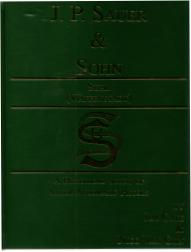 |
Fallschirmjagergewehr 42 (FG 42) |  |
|
|
|
|
CRUFFLER.COM
presents
HISTORIC
FIREARM
OF THE MONTH,
November
2000:
 |
Fallschirmjagergewehr 42 (FG 42) |  |
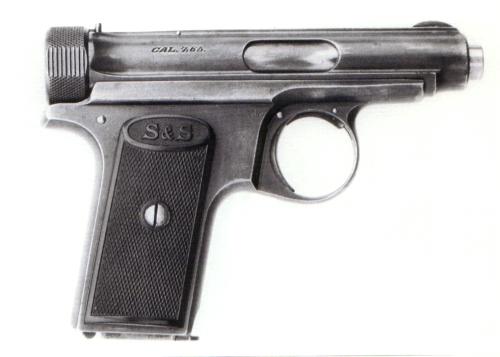
Image credit: Cate, Jim and Nico Van Gijn, J.P. Sauer & Sohn, Suhl, Walsworth Publishing, Marceline, Missouri: 1996 Page 58 |
SPECIFICATIONS
Type: Self Loading Pocket Pistol System of Operation: Blowback Caliber: 7.65mm Browning (.32 ACP) Capacity: 7+1 Sights front: Blade Sights, rear: Notch Length: 5.75" Weight (unloaded): 21 ounces Barrel: 2.9" Rifling: Six groove, right hand twist |
J.P. Sauer
& Sohn
In 1751, Johann
Paul Sauer set up shop in the town of Suhl, Germany and set about the manufacture
of firearms. His was a family business, handed down to from father
to son. In time, the company (Which had come to be known as Spangenberg
& Sauer) began to prosper. In 1811 it was the first gun manufacturer
in Suhl to win a contract from the German military. In addition to
rifles made pursuant to the military contract, the firm also made quality
hunting arms. In response to a government directive mandating more
centralized production of military rifles, a new factory was opened in
Suhl in late 1838. This factory combined the efforts of Spangenberg
& Sauer with another small gunmaking concern called Sturm. Orders
for rifles from the various German states continued to grow in number,
causing the firm to acquire more space, more machines and to hire more
people. By 1858 some two hundred and sixty people were employed.
Military production continued to increase, and among the firm's products
were both the Dreyse Needle Rifle and the Mauser Model 1871 bolt action
rifle.
After the Franco-Prussian war's conclusion, the pace of military procurement slackened. As a result, in 1882 Rudolf and Franz Sauer made a decision to suspend military production and concentrate solely on sporting arms. This decision resulted in the dissolution of the Spangenberg, Sauer, & Sturm corporation. From this time onward the firm was known as J.P. Sauer & Sohn. In 1914, Sauer again realigned production priorities to provide for military need, and the company produced many thousands of firearms for military use. Sauer's chief design engineer at this time was a prolific gentleman named Fritz Zehner. Zehner was to design every pistol that Sauer produced, from the collaborative Roth-Sauer to the Models 1913, 1930, Behorden, and 38-H. As indicated, Sauer began its foray into the world of pistols with the Roth-Sauer.
| Designed primarily by Roth, Sauer's involvement was as the manufacturer. As made by Sauer, the gun was offered only in 7.65mm Roth-Sauer. Later the gun was adopted by the Austrian military after a redesign that enabled it to chamber the larger and more powerful 9mm Steyr cartridge. |
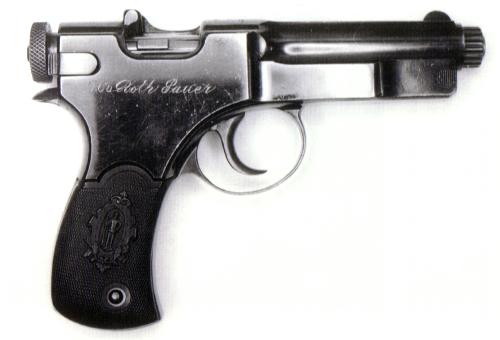
Image credit: Cate, Jim and Nico Van Gijn, J.P. Sauer & Sohn, Suhl, Walsworth Publishing, Marceline, Missouri: 1996 Page 40 |
Model 1913
Following
close on the heels of the Roth-Sauer was the Model 1913. Coming off
the line just prior to the First World War, the gun found itself immediately
drafted into service. It was a popular sidearm with both officers
and NCO's of the German Army and many were procured through official channels.
Still more were privately purchased by both enlisted soldiers and officers.
Officially procured Model 1913's bear imperial acceptance stampings.
With the war's end in November 1918, Model 1913 production was suspended
for four years. Production resumed in 1922, and continued uninterrupted
until 1935.
The Model 1913, or "Old Model" differed considerably from the Roth-Sauer: It was a blowback (unlocked breech) design using a recoil spring that surrounded the fixed barrel. It was significantly smaller, with an overall length of slightly less than 5.75", a height of just 3.7", and a barrel of 2.9". The pistol uses a striker firing mechanism; pressure on the trigger causes the triggerbar to move to the rear and down, where it disengages from the striker's nose and frees it to go forward under spring pressure and fire the cartridge. There is a safety catch on the left side of the pistol that prevents the trigger from moving when engaged. Like many other pistols of its time, the Model 1913 bears both a serial number and a set of internal assembly numbers. This can be confusing to those unaware of the additional numbering - many have thought their pistols bore mismatched serial numbers when they were, in fact, doubly matching!
Disassembly of the Model 1913 is effected by drawing the slide to the rear and pressing the slide lock (which does not act as a last round hold open), located
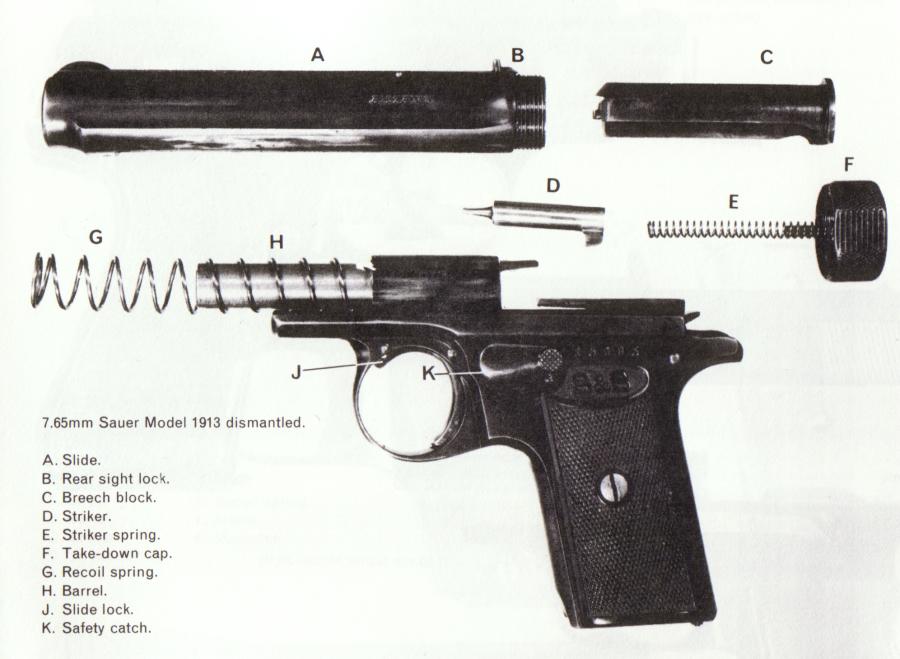
Image Credit: Boothroyd, Geoffrey, The Handgun, The Sportsman's Press, London: 1988 Page 487 |
Of special note is Zehner's use of a separate and discrete breechblock, instead of machining it as part of the slide. At first glance, in comparison with contemporaries such as the Browning Model 1910, or the Walther Model 4, the pistol seems excessively complicated. Further examination, however, bears out the wisdom of Zehner's design. In the Browning, the barrel must be made as a separate component in order to remove the slide. As a result, the barrel to frame fit represents an additional critical tolerance in the pistol's design. The Walther uses a fixed barrel like the Sauer. Disassembly of the Walther is effected by pulling the slide to the rear and upwards. This disassembly method necessarily requires looser tolerances between the slide and barrel than with designs where the slide can run forward off the frame. In contrast, the Sauer design marries the best of both worlds. The barrel is fixed, obviating any concerns about barrel to frame fit and the slide needs move along only one axis, permitting tighter tolerances than possible with a slide that must pivot for disassembly. While these concerns may seem superfluous in a pocket pistol with a 3" barrel, it must be noted that the Sauer Model 1913 enjoyed a reputation for accuracy and reliability far in excess of its contemporaries.
The Model 1913, as with all early Sauers, was made to extremely high standards of fit and finish. Most specimens will show little or no slide to frame lateral play and have surprisingly crisp triggers for striker fired pistols. They were finished with a high polish rust blue, with some parts, such as the barrel, breechblock, and striker being left in the white. Stocks are of hard rubber with the "S&S" logo at the top.
Zusatzsicherung
| Later versions of the Model 1913 were equipped with an additional safety mechanism referred to as the Zusatzsicherung (which means "additional safety"). This feature takes the form of a small oval protrusion that can be seen between the safety lever and the top of the left grip when the safety is "off." When the lever is pushed down into the "safe" position, the lever forces the oval protrusion into a slot on the triggerbar and thus prevents any movement of the triggerbar. |
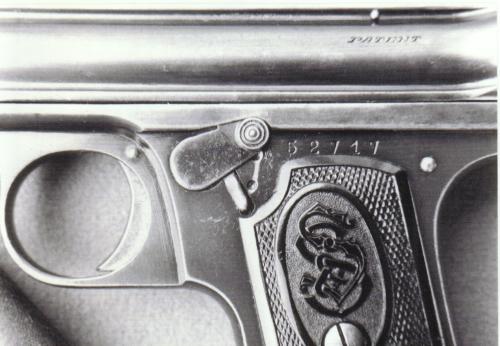
Image credit: Cate, Jim and Nico Van Gijn, J.P. Sauer & Sohn, Suhl, Walsworth Publishing, Marceline, Missouri: 1996 Page 73 |
Exports
and Variants
The Model
1913 was exported in significant numbers to England, Holland, the United
States, Russia, and France. On order, customers could have barrels
made from a particular Krupp alloy steel, a nickel finish, and grip materials
ranging from horn to bone to ivory.
Conclusion
The Sauer
Model 1913 is often overlooked by collectors dazzled by names like Browning,
Luger and Walther. That's a shame as the M1913 is one of the finest
examples of innovation and craftsmanship produced by any early 20th century
gun maker in any country. The 1913 also has tremendous historical
significance, having armed Germany's military in two world wars, Weimar
Republic police agencies, and other police agencies around Europe following
the Second World War. Combined, these attributes define a classic
example of the gunmaker's art that should not be overlooked by either historian
or collector.
BIBLIOGRAPHY
Boothroyd, Geoffrey, The Handgun, (The Sportsmans Press, London: 1988)
Cate, Jim and
Nico Van Gijn, J.P. Sauer & Sohn, Suhl, (Walsworth Publishing
Company, Marceline, Missouri: 1996)
The Handgun
is
available from IDSA Books. Click on the image to order:
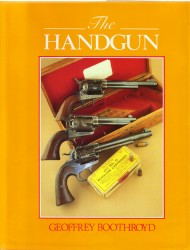
J.P Sauer
& Sohn, Suhl is available from IDSA Books. Click on the image
to order:
